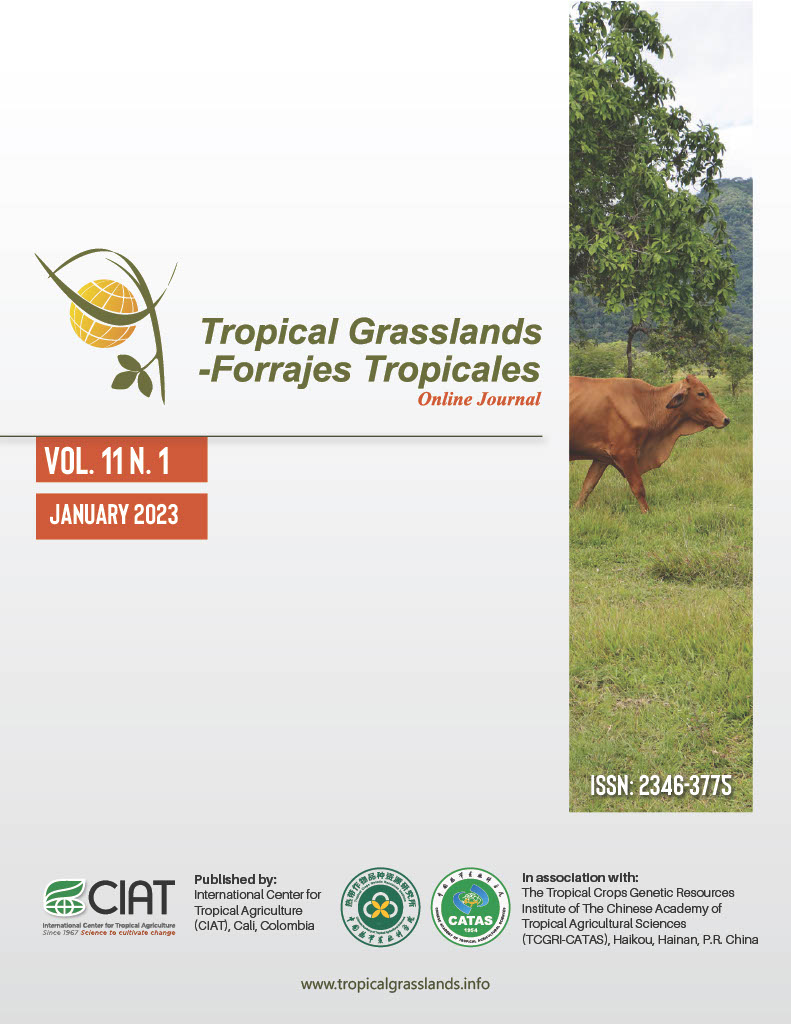Effect of different mulch levels on germination, survival, and establishment of Tithonia diversifolia (Hemsl.) A. Gray. vc ICACUBA Oc-10, planted with gamic seeds under field conditions
DOI:
https://doi.org/10.17138/tgft(11)31-40Abstract
Different mulch levels were studied for establishing tithonia using gamic seeds. A randomized complete block design with 5 replications was used. The treatments included covering the seeds with 0, 0.250, 0.338 and 0.500 kg/m2 of African star grass dry residues. The germination percentage was lower (P<0.05) for the control treatment, at 12 and 30 days after sowing and increased up to 29 % when 0.500 kg/m2 of mulch was applied. In the first stages after sowing (12, 34, 54 and 78 days) the percentage of germination, number of tillers and leaves/plant, height and stem diameter were significantly higher for the mulch treatments. Forage yield in the first harvest increased significantly (P<0.05) with mulch levels, from 6.43 to 10.87 t DM/ha. In the third harvest, the best (P<0.05) yields (5.6-6.0 t DM/ ha) were obtained with 0.338 and 0.500 kg of mulch/m2. It is concluded that it is necessary to cover tithonia seeds with mulch of vegetable residues at a rate of 0.338–0.500 kg/m2, to ensure proper germination, survival and development of the plants, and higher biomass yields.
Author Biographies
César Padilla, Instituto de Ciencia Animal
Departamento de Pastos. Investigador titular
Idalmis Rodríguez, Instituto de Ciencia Animal
Departamento de Pastos
Tomas E. Ruiz, Instituto de Ciencia Animal
Departamento de Pastos. Investigador titular
Yolaine Mesa, Instituto de Ciencia Animal
Departamento de Biomatemática
Nadia Quiñones, Instituto de Ciencia Animal
Departamento de Pastos.
References
Agboola DA; Idowu WF; Kadiri M. 2014. Seed germination and seedling growth of the Mexican sunflower Tithonia diversifolia (Compositae) in Nigeria, Africa. Revista Biologia Tropical 54(2): 395–402. doi: 10.15517/rbt.v54i2.13881
Conover W. 1999. Practical Nonparametric Statistics. John Wiley & Sons, Inc., New York. 3rd ed. 584 p.
Di Rienzo JA; Casanoves F; Balzarini MG; González L; Tablada M; Robledo C W. 2012. InfoStat versión 2012 Grupo InfoStat, FCA, Universidad Nacional de Córdoba, Argentina. infostat.com.ar
Duncan DB. 1955. Multiple Range and Multiple F Tests. Biometrics 11(1):1–42. doi: 10.2307/3001478
Gallego-Castro LA; Mahecha-Ledesma L; Angulo-Arizala J. 2015. Crecimiento y desarrollo de Tithonia diversifolia Hemsl. A Gray en condiciones de trópico alto En: Peri P (ed). Memorias III Congreso Nacional de Sistemas Silvopastoriles y VII Congreso Internacional Sistemas Agroforestales. Editorial INTA, Santa Cruz, Argentina, 53–57. bit.ly/3X5QkFF
Gallego-Castro LA. 2016. Evaluación agronómica y análisis productivo del botón de oro (Tithonia diversifolia Hemsl. A Gray) como suplemento alimenticio de vacas lecheras en trópico alto. MSc. Tesis. Universidad de Antioquia, Antioquia, Colombia. handle.net/10495/6113
Gallego-Castro LA; Mahecha-Ledesma L; Angulo-Arizala J. 2017. Calidad nutricional de Tithonia diversifolia Hemsl. A Gray bajo tres sistemas de siembra en el trópico alto. Agronomía Mesoamericana 28(1):213–222. doi: 10.15517/am.v28i1.21671
González D; Ruiz TE; Díaz H. 2013. Stem section and planting method: its effect on Tithonia diversifolia biomass production. Cuban Journal of Agricultural Science 47(4)425–429. bit.ly/3CMTJRl
Hernández A; Pérez JM; Bosch D; Castro N. 2015. Clasificación de los suelos de Cuba 2015. Mayabeque, Cuba: Ediciones INCA, 93 p. bit.ly/3GYmahG
Herrera RS; García M; Cruz AM. 2016. Relación entre algunos indicadores climáticos con la altura, rendimiento y población de clones de Pennisetum purpureum. Avances en Investigación Agropecuaria 20(2):33–41. bit.ly/3H9MWUL
Herrera RS; García M; Cruz AM; Romero A. 2018. Estudio del régimen de precipitaciones pluviales en dos áreas del Instituto de Ciencia Animal. Avances en Investigación Agropecuaria 22(1):7–17. bit.ly/3XdkqH3
Levene H. 1960. Robust tests for the equality of variance In: Olkin I, ed. Contributions to Probability and Statistics: Essays in Honor of Harold Hotelling, Stanford University Press, 278–292, ISBN: 978-0-8047-0596-7.
Mahecha L; Angulo J. 2017. Experiencia investigativa sobre Tithonia diversifolia. Universidad de Antioquia. En: Chará J; Peri P; Rivera J; Murgueitio E; Castaño K (eds). Sistemas Silvopastoriles: Aportes a los Objetivos de Desarrollo Sostenible. CIPAV. Cali, Colombia. ISBN 978-958-9386-78-1
Mattar EPL; Vianna TT; Pereira WD; Brasileiro BP; Hilst PC; Días DCFS. 2019. Physiological quality of Tithonia diversifolia (Hemsl.) A. Gray seeds as a function of harvest period and storage conditions. Bulgarian Journal of Agricultural Science 25(6):1133–1142. bit.ly/3GMw58L
Muoghalu JI; Chuba D. 2005. Seed germination and reproductive strategies of Tithonia diversifolia (Hemsl.) Gray and Tithonia rotundifolia (P.M) Blake. Applied Ecology
and Environmental Research 3(1): 39–46. bit.ly/3Xli0X6
Obukohwo E; Olayinka UO. 2015. Seed production, germination, emergence and growth of Tithonia diversifolia (Hemsl.) A. Gray as influenced by different sowing depths and soil types. Albanian Journal of Agricultural Sciences 14(3):294299. bit.ly/3w459fU
Padilla C; Rodríguez I; Ruíz TE; Herrera M. 2018. Determinación del mejor momento de cosecha de semilla gámica, Tithonia diversifolia (Hemsl.) Gray. Livestock Research for Rural Development 30(4):71. bit.ly/3Gz8Krb
Padilla C; Rodríguez I; Ruiz TE; Ojeda M; Sarduy L; Díaz L. 2020a. Evaluación de diferentes prácticas de protección de la semilla gámica en el establecimiento de Tithonia diversifolia (Hemsl.) Gray vc material 16. Livestock Research for Rural Development 32(3):50. bit.ly/3QGOQz2
Padilla C; Rodríguez I; Herrera M; Ruíz T; Mesa Y; Sarduy L. 2020b. Mejor momento de cosecha en la producción y calidad de semilla gámica de Tithonia diversifolia (Hemsl.) A.Gray según estado fenológico de la estructura floral. Livestock Research for Rural Development 32(9):146. bit.ly/3D38U9x
Ramírez J. 2008. Cultivo botón de oro “Tithonia diversifolia”. Artículo técnico. Engormix. bit.ly/3ZF5C5L
Ríos Kato CI. 1999. Tithonia diversifolia (Helms.) Gray, una planta con potencial para la producción sostenible en el trópico. En: Sánchez MD; Rosales Meléndez M (eds). Memorias de una conferencia electrónica sobre Agroforestería para la producción animal en Latinoamérica. Estudio FAO producción y sanidad animal. Fundación CIPAV y FAO, 143:311–325. bit.ly/3kifous
Rodríguez I; Padilla C; Ojeda M. 2019. Características de la germinación de la semilla gámica de Tithonia diversifolia (Hemsl.) Gray y su comportamiento en condiciones de vivero. Livestock Research for Rural Development 31(5):69. bit.ly/3GKdtGL
Romero O; Galindo A; Murgueitio E; Calle Z. 2014. Primeras experiencias en la propagación del botón de oro (Tithonia diversifolia, Hemsl. Gray) a partir de Semillas para la siembra de sistemas silvopastoriles intensivos en Colombia. Tropical and Subtropical Agroecosystems 17(3):525–528. bit.ly/3w5fvw3
Ruíz TE; Febles G; Díaz H. 2012. Plantation distance, frequency and cutting height on the biomass production of Tithonia diversifolia collection 10 during the year. Cuban Journal of Agricultural Science. 46(4):423–426. bit.ly/3IWCaCB
Ruíz TE; Febles G; Achan G; Díaz, H; González J. 2018. Capacidad germinativa de semilla gámica de materiales colectados de Tithonia diversifolia (Hemsl.) Gray en la zona centro-occidental de Cuba. Livestock Research for Rural Development 30(5):81. bit.ly/3keNShn
Saavedra S. 2016. Fenología y fisiología de semillas de botón de oro Tithonia diversifolia (Hemsl.) Gray. MSc. Tesis. Universidad Nacional de Colombia, Antioquia, Colombia. handle/unal/58749/1128408177.2016.
Sánchez Núñez LM; Hernández Bernal DM; Sánchez Moreno HV. 2014. Dinámica de la germinación y agrotecnia para un eficiente desarrollo del botón de oro (Tithonia difersifolia). Revista Sistemas de Producción Agroecológicos 5(2):59–81. doi: 10.22579/22484817.655
Santos-Gally R; Muñoz M; Franco G. 2019. Efecto de la latencia sobre la germinación de Tithonia diversifolia (Asteraceae). En: Rivera J; Peri P; Chará J; Díaz M; Colcombet L; Murgueitio E (eds). X Congreso internacional sobre sistemas silvopastoriles: por una producción sostenible. Libro de Actas. Editorial CIPAV, Cali, Colombia, 416–424. bit.ly/3GX5MxY
Shapiro SS; Wilk MB. 1965. An analysis of variance test for normality (complete samples). Biometrika 52(3-4):591–611. doi: 10.2307/2333709
Solarte LH; Murgueitio E; González JG; Uribe F; Manzano L. 2013. Protocolo para la siembra de botón de oro y leucaena en potreros con praderas mejoradas para el establecimiento de sistemas silvopastoriles intensivos. Fundación CIPAV. Bogotá. Colombia. 20 p. bit.ly/3QKhoaR
How to Cite
Downloads
Downloads
Published
Issue
Section
License
Copyright (c) 2023 Tropical Grasslands-Forrajes Tropicales

This work is licensed under a Creative Commons Attribution 4.0 International License.




